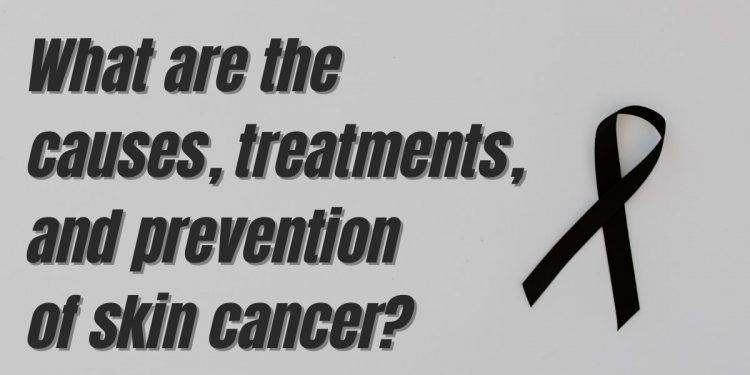You will learn about treatments for skin cancer and its causes and prevention in this blog. Firstly I will tell you about Skin cancer, which starts in the skin cells. The most common types of skin cancer are basal cell carcinoma, squamous cell carcinoma, and melanoma.
The excessive growth of abnormal skin cells is known as skin cancer. Malignant tumors grow when skin cells suffer damage, most frequently brought on by UV radiation from sunlight or tanning beds.
Cancerous tumors have the potential to spread to other body parts, especially essential organs, if untreated. Although skin cancer is the most prevalent type, it is also the easiest to treat when detected and treated early. Here are some causes, treatments, and prevention measures for skin cancer:
Causes
The causes of skin cancer can be categorized into several main factors, including:
1. Exposure to UV radiation:
The most common cause of skin cancer is exposure to ultraviolet (UV) radiation from the sun or tanning beds. Prolonged and frequent exposure to UV radiation damages the DNA in skin cells, which can lead to the development of skin cancer.
2. Genetics:
Some people may be at higher risk of developing skin cancer due to genetic factors. Inherited mutations in certain genes can increase the risk of developing skin cancer, such as mutations in the CDKN2A gene, which is associated with an increased risk of melanoma.
3. Immune system suppression:
People with weakened immune systems, such as those who have had organ transplants, are at a higher risk of developing skin cancer. This is because a healthy immune system is better able to detect and destroy cancer cells before they have a chance to grow and spread.
4. Age:
The risk of developing skin cancer increases with age. This is because, over time, the skin is exposed to more UV radiation, and the body’s ability to repair damaged skin cells decreases.
5. Other factors:
Other factors that can increase the risk of skin cancer include having fair skin, a history of sunburns, exposure to certain chemicals, and a history of skin cancer.
It is important to take steps to protect your skin from UV radiation, such as wearing protective clothing and sunscreen, to reduce the risk of developing skin cancer. Regular skin exams by a dermatologist can also help detect skin cancer early, improving the chances of successful treatment.
Treatments
As mentioned earlier, the most common treatments for skin cancer are surgery, radiation therapy, chemotherapy, and immunotherapy. Let’s take a closer look at each of these treatments:
1. Surgery:
Surgery is the most common treatment for skin cancer. The surgeon removes the cancerous tissue and a small margin of healthy tissue around it. Sometimes, the surgeon may need to remove nearby lymph nodes if cancer has spread.
2. Radiation therapy:
Radiation therapy uses high-energy X-rays to kill cancer cells. This treatment may be used after surgery to kill any remaining cancer cells or in cases where surgery is impossible.
3. Chemotherapy:
Chemotherapy is a drug therapy that uses chemicals to kill cancer cells. This treatment is not commonly used for skin cancer but may be used in cases where cancer has spread to other body parts.
4. Immunotherapy:
Immunotherapy is a drug therapy that helps the body’s immune system fight cancer. This treatment boosts the immune system’s ability to recognize and attack cancer cells. It is often used to treat advanced cases of melanoma.
5. Other treatments for skin cancer:
Furthermore, Other treatments for skin cancer may include cryotherapy, which involves freezing the cancerous tissue, and photodynamic therapy, which involves applying a medication to the skin and then exposing it to a special light to destroy the cancer cells.
Prevention
Prevention is key when it comes to skin cancer. Here are some steps you can take to reduce your risk of developing skin cancer:
1. Sun protection:
Protect your skin from the sun’s harmful UV rays by wearing protective clothing, such as wide-brimmed hats, long-sleeved shirts, and sunglasses. Use sunscreen with a Sun Protection Factor (SPF) of at least 30 and reapply it every two hours or after swimming or sweating.
2. Avoid tanning beds:
Tanning beds emit UV radiation and can increase the risk of cancer. Avoid using tanning beds altogether.
3. Regular skin exams:
Regular exams by a dermatologist can help detect skin cancer early. Check your skin regularly for any new moles, freckles, or other marks that look unusual.
4. Know your skin:
Be aware of any changes in the size, shape, or color of moles or other skin lesions, and report them to a doctor. If you notice any new or changing spots, have them checked by a dermatologist.
5. Healthy lifestyle:
A healthy lifestyle that includes a balanced diet, regular exercise, and not smoking can help reduce the risk of skin cancer. A diet rich in fruits, vegetables, and whole grains helps protect the skin.
Taking these steps can help protect your skin from the sun’s harmful rays and reduce your risk of skin cancer. If you have concerns about your skin or notice any changes, you must talk to a dermatologist. Early detection and treatment can improve the chances of a successful outcome.
conclusion
Skin cancer is a disease in which skin cells proliferate uncontrollably. It is primarily caused by excessive UV light exposure, which damages DNA. More Americans are affected by cancer than by all other cancers combined.
Having light-colored skin, having a lot of moles, having a family history of skin cancer, and other aspects are risk factors in addition to exposure to UV rays.















































